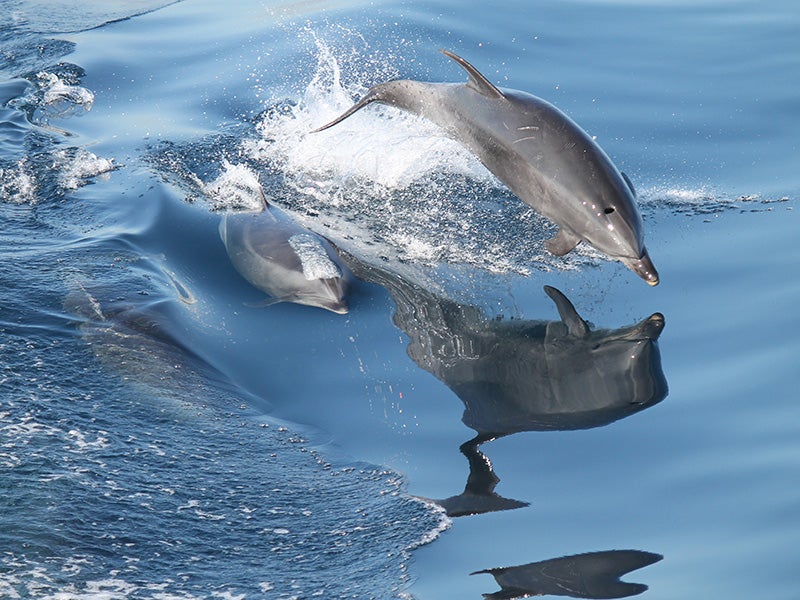Navy Rethinks Pacific Training that Endangers Whales, Dolphins and Other Marine Life
New environmental impact statement required for destructive sonar and explosives use
Contact
The U.S. Navy today said it plans to prepare a new environmental impact statement for training and testing exercises in the Pacific Ocean from December 2018 onward, including the use of sonar and explosives that threaten widespread harm to whales, dolphins, other marine mammals and imperiled sea turtles. The move follows a March 31 federal court ruling that the Navy illegally failed to consider restricting military exercises in biologically important areas within the Hawaii-Southern California Training and Testing Study Area to reduce harm to marine mammals.
“The Navy doesn’t need to blow up breeding areas or blast migrating whales with sonar so we’re glad they’re taking a closer look at this critical issue,” said Miyoko Sakashita, oceans program director for the Center for Biological Diversity. “The Navy doesn’t need continuous access to every square inch of the Pacific. It’s a big ocean, and we need protections for the areas that are particularly important for whales and dolphins.”
Dan J. Mcsweeney / Cascadia Research Collective – Wild Whale Research Foundation
False killer whales swim on the west side of Hawai‘i Island, in an area that will have protections from use of sonar and explosives under the September settlement with the U.S. Navy .
The Navy’s current five-year training plan was overturned after a legal challenge in federal court by Earthjustice, representing Conservation Council for Hawaiʻi, the Animal Welfare Institute, the Center for Biological Diversity and the Ocean Mammal Institute. In a September 2015 settlement, the Navy agreed to put important habitat for numerous marine mammal populations off-limits to dangerous, mid-frequency sonar training and testing and the use of powerful explosives during the remainder of the five-year plan, which expires in December 2018.
“The science is clear. To avoid permanent injuries and death to whales, dolphins and other marine mammals, it is vital to keep Navy sonar and explosives out of the areas these animals need for essential activities like feeding, resting and caring for their young,” explained Earthjustice attorney David Henkin, who represented the conservation groups in the federal court case. “When it voluntarily agreed to the settlement, the Navy made clear that it can both perform its mission and stay out of important marine mammal habitat.”
“We urge the public to get involved and tell the Navy its new study needs to examine ways to keep destructive training out of vital marine mammal habitat,” said Marjorie Ziegler, executive director of Conservation Council for Hawaiʻi.
The public comment period on the new environmental impact statement ends Jan. 12, 2016. The public can submit comments online at: http://hstteis.com. The public can also attend one of three scoping meetings: Dec. 1 in San Diego, Calif.; Dec. 3 on Kauaʻi, Hawaiʻ</span>i; and Dec. 5 in Honolulu, Hawaiʻi.
Despite the March ruling and September settlement, the Navy continues to conduct military exercises that can injure and kill marine wildlife. On Nov. 4, the National Marine Fisheries Service said it is investigating the death of two dolphins that washed ashore near San Diego after Navy ships were using sonar in the area.
“The bottlenose dolphins that died last month off San Diego likely came from a population that numbers less than 400,” said Susan Millward, executive director at the Animal Welfare Institute. “We need to keep up the pressure on the Navy to do more to protect these highly intelligent and vulnerable animals.”
Background
Ocean mammals depend on hearing for navigation, feeding and reproduction. Scientists have linked military sonar and live-fire activities to mass whale beaching, exploded eardrums and even death. In 2004, during war games near Hawaiʻi, the Navy’s sonar was implicated in a mass stranding of up to 200 melon-headed whales in Hanalei Bay, Kauaʻi.
The Navy and Fisheries Service estimate that, over the current plan’s five-year period, training and testing activities will result in thousands of animals suffering permanent hearing loss, lung injuries or death. Millions of animals will be exposed to temporary injuries and disturbances, with many subjected to multiple harmful exposures.
Watch a video on the effects of Navy sonar training on marine mammals:

Additional Resources
About Earthjustice
Earthjustice is the premier nonprofit environmental law organization. We wield the power of law and the strength of partnership to protect people's health, to preserve magnificent places and wildlife, to advance clean energy, and to combat climate change. We are here because the earth needs a good lawyer.